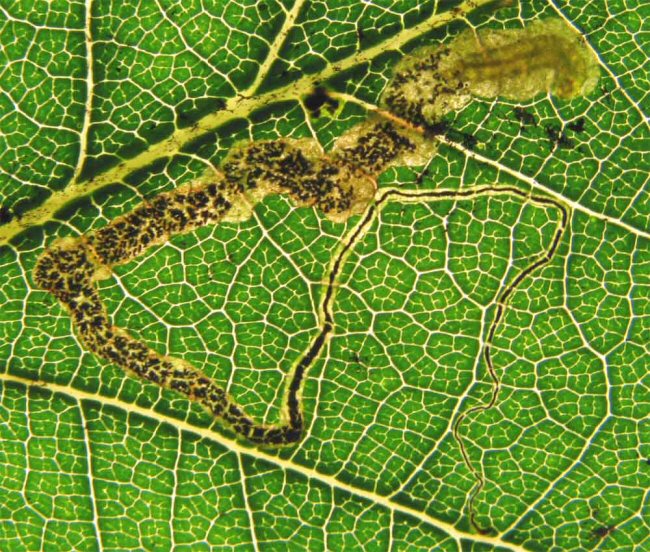|
||||||
|
Stigmella
svenssoni (Johansson, 1971) Orange-headed Pigmy Nepticula
svenssoni
Johansson, 1971. Ent. Scand.
2: 249, fig'd. |
||||||||||||||||||||||||||||||||||||||||
Leaf-miner: The larval mine is a long gallery with linear black frass to begin with, subsequently neatly scattered, and finally more central and irregular. The egg is usually laid on the underside of the leaf (UKMoths). Forms a long, relatively wide mine. The frass is initially in a thin central line, but later may vary from a thin central line to frass almost filling the mine (British leafminers). Oviposition at the underside of the leaf. The mine is a remarkably long, not very slender corridor. Frass line of inconstant width, mostly occupying more than half the width of the gallery (Bladmineerders van Europa). It is recommended that you try to rear out the adults to be certain of their identity.
Larva: The larvae of moths have a head capsule and chewing mouthparts with opposable mandibles (see video of a gracillarid larva feeding), six thoracic legs and abdominal legs (see examples). Yellow, head brown (Borkowski, 1972b; Gustafsson and van Nieukerken (1990a). Abdomen 9 with two pairs of setae (other species, as far as known, having three pairs) (Bladmineerders van Europa). Pupa: The pupae of moths have visible head appendages, wings and legs which lie in sheaths (see examples). Adult: The adult is illustrated in UKMoths. The species is included in mothdissection.co.uk. Hosts in Great Britain and Ireland:
Hosts elsewhere:
Time of year - larvae: July to September (UKMoths). Time of year - adults: Thought to be only a single extended generation, adults in May and June (UKMoths). Distribution in Great Britain and Ireland: Britain including Banffshire, Berkshire, Breconshire, Cambridgeshire, Dumfireshire, Dunbartonshire, East Kent, East Norfolk, East Ross, East Suffolk, East Sutherland, Glamorgan, Haddington, Huntingdonshire, Merionethshire, Montgomeryshire, North Aberdeenshire, North Devon, North Northumberland, North Wiltshire, Shropshire, South Aberdeenshire, South Essex, South Hampshire, South Northumberland, South Wiltshire, South-west Yorkshire, Stirlingshire, Surrey, West Cornwall, West Norfolk, West Ross, West Sutherland and Worcestershire (NBN Atlas). See also British leafminers distribution map. Also doubtfully recorded in the Republic of Ireland (Fauna Europaea and National Biodiversity Data Centre Map). Distribution elsewhere: Widespread in continental Europe including Danish mainland, Finland, French mainland, Germany, Greek mainland, Hungary, Italian mainland, Latvia, Norwegian mainland, Slovakia, Sweden and The Netherlands (Fauna Europaea). NBN Atlas links to known host species:
British and Irish Parasitoids in Britain and elsewhere: Currently unknown. |
||||||||||||||||||||||||||||||||||||||||
|
|
|
| External links: | Search the internet: |
|
Belgian Lepidoptera Biodiversity Heritage Library Bladmineerders van Europa British leafminers Encyclopedia of Life Fauna Europaea NBN Atlas NHM UK Checklist UKMoths |
Find
using Google Find using Google Scholar Find images using Google |
| Last updated 09-Jun-2019 Brian Pitkin | ||

